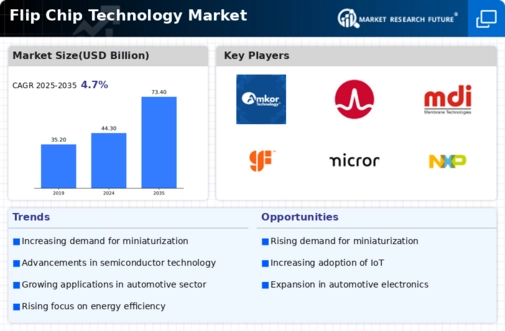Top Industry Leaders in the Flip Chip Technology Market

Competitive Landscape of Flip Chip Technology Market:
The flip chip technology market, valued at approximately USD 31.3 billion in 2022, is projected to experience a steady climb, reaching an estimated USD 47.6 billion by 2032. This growth is fueled by the insatiable demand for smaller, faster, and more powerful electronics, where flip chip technology reigns supreme. Understanding the competitive landscape in this dynamic market is crucial for established players and new entrants alike.
Key Players
- Samsung Group (South Korea)
- Intel Corporation (U.S.)
- Global Foundries (U.S.)
- UMC (Taiwan)
- ASE Inc. (Taiwan)
- Amkor Technology (U.S.)
- STATS ChipPAC (Singapore)
- Powertech Technology (Taiwan)
- STMicroelectronics (Switzerland)
- Texas Instruments
Strategies Adopted by Key Players:
Leading players are adopting various strategies to secure their position in the market. These include:
- Continuous Innovation: Investing in R&D to develop new bumping materials, underfill technologies, and flip-chip packaging solutions for diverse applications.
- Vertical Integration: Expanding into different segments of the value chain, such as raw material supply and equipment manufacturing, to gain control over costs and quality.
- Strategic Partnerships: Collaborating with other companies in the ecosystem, including chip designers and manufacturers, to offer integrated solutions and access new markets.
- Focus on Regional Expansion: Targeting high-growth regions like Asia-Pacific and Eastern Europe to capture emerging market opportunities.
Factors for Market Share Analysis:
- Technology Leadership: Continuous innovation in bumping techniques, underfill materials, and testing methods is paramount for success. Players who consistently push the boundaries of technology attract high-value customers and secure long-term contracts.
- Production Capacity: The ability to meet the ever-growing demand for flip chip packaging is crucial. Large-scale production facilities and robust supply chains are essential for staying competitive.
- Cost Competitiveness: While technology and capacity are important, cost remains a major factor for many customers. Optimizing production processes and finding cost-effective materials are key to attracting price-sensitive segments.
- Geographical Reach: Having a strong presence in key regions like Asia, North America, and Europe allows players to cater to diverse customer needs and adapt to regional market dynamics.
- Customer Relationships: Building strong relationships with chipmakers and OEMs is essential for securing long-term partnerships and gaining market insights.
New and Emerging Companies:
- Start-ups: Companies like X-Fab and SiTime are focusing on developing next-generation flip chip solutions for specific applications like wearables and medical devices. Their agility and innovative approaches offer a fresh perspective to the market.
- Material and Equipment Suppliers: Companies like Dow Chemical and Asahi Kasei are developing new materials for bump formation and underfill, improving performance and reliability. Similarly, equipment manufacturers like ASM International and Applied Materials are introducing innovative flip chip assembly tools, streamlining production processes.
Industry Developments
Samsung Group:
- May 2023: Unveiled a new high-efficiency, low-current flip-chip LED with enhanced epi-growth and electrode reflection technology.
- April 2022: Introduced a next-generation flip-chip package for power modules featuring improved thermal performance and reduced parasitic inductance.
- March 2021: Announced significant progress in developing 3D NAND with flip-chip integration, enabling higher density and faster I/O speeds.
Intel Corporation:
- October 2023: Showcased Foveros Direct, a 3D packaging technology using flip-chip integration for high-performance computing processors.
- August 2022: Achieved industry-first 100 Gbps signal transmission with flip-chip interposers for high-bandwidth applications.
- December 2021: Began production of Meteor Lake processors utilizing Intel's EMIB (Embedded Multi-die Interposer Bridge) technology, which incorporates flip-chip integration.
